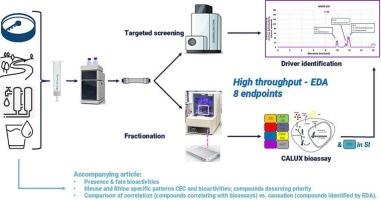基于效果的监测与(饮用)水的目标筛选的结合II:影响生物测定活性的化合物的效果导向分析
IF 9.7
1区 环境科学与生态学
Q1 ENVIRONMENTAL SCIENCES
引用次数: 0
摘要
生物测定法在化学水质监测中的应用越来越广泛。为了确定升高的生物测定活性是否表明存在风险,需要对活性物质进行鉴定。本研究调查了在莱茵河和默兹河荷兰部分地区的饮用水公司的来源和处理中,CALUX生物测定法检测到的10种生物活性和化学污染物的存在和命运。随附的文章报道了这一点。由于层次聚类分析方法所阐明的相关性并不能在所有情况下揭示致病化合物,因此本文进行了效应导向分析(EDA)并进行了报道。通过在早期开发的高通量EDA平台中嵌入p53和Nrf2 CALUX生物测定(分别用于遗传毒性和氧化应激),实现了对多个不同终点的贡献者的识别。该平台结合了微分离、小型化生物测定和高分辨率质谱靶向筛选,并应用于8个样品。天然和合成类固醇激素及其代谢物被确定为雄激素、雌激素、糖皮质激素和孕激素活动的贡献者。14种农药被发现具有抗雄激素、抗孕激素和/或细胞毒性活性,突显了公众对农药使用的日益关注。两种药物导致了污水处理厂出水样品中的氧化应激。尽管p53 CALUX检测已成功集成到EDA平台中,但由于缺乏可检测活性,因此无法应用于水样。应用EDA平台被证明是强大的识别生物活性化合物在水中具有高终点覆盖率和高通量格式。EDA创建了一个综合的和基于风险的观点,对那些污染物恶化化学水质。本文章由计算机程序翻译,如有差异,请以英文原文为准。

Combination of effect-based monitoring and targeted screening of (drinking)water II: Effect directed analysis of compounds responsible for bioassay activity
Bioassays are increasingly applied in the monitoring of chemical water quality. To determine whether elevated bioassay activities indicate a risk, identification of the active substances is needed. This study investigated the presence and fate of 10 biological activities detected by CALUX bioassays and chemical contaminants detected by targeted screening in sources and treatments of drinking water companies in the Dutch parts of the Rhine and Meuse catchments. This was reported in the accompanying article. As the correlations elucidated by the hierarchical cluster analysis approach did not in all cases reveal the causative compounds, effect directed analysis (EDA) was performed and reported in this article. By embedding the p53 and the Nrf2 CALUX bioassays (for genotoxicity and oxidative stress, respectively) in an earlier developed high throughput EDA platform, the identification of contributors to multiple different endpoints was achieved. The platform combined microfractionation, miniaturised bioassays and targeted screening using high resolution mass spectrometry, and was applied to eight samples. Natural and synthetic steroid hormones and their metabolites were identified as contributors to androgenic, estrogenic, glucocorticoid and progestogenic activities. Fourteen pesticides were found to contribute to anti-androgenic, anti-progestogenic and/or cytotoxic activities, underlining the increasing public concern of pesticide use. Two pharmaceuticals contributed to oxidative stress in the WWTP effluent sample. Although the p53 CALUX assay was successfully integrated in the EDA platform, is was not applied to water samples due to lack of detectable activity. The applied EDA platform proved to be powerful to identify bioactive compounds in water with a high endpoint coverage in a high throughput format. EDA creates an integrated and risk-based view on those contaminants that deteriorate chemical water quality.
求助全文
通过发布文献求助,成功后即可免费获取论文全文。
去求助
来源期刊

Environment International
环境科学-环境科学
CiteScore
21.90
自引率
3.40%
发文量
734
审稿时长
2.8 months
期刊介绍:
Environmental Health publishes manuscripts focusing on critical aspects of environmental and occupational medicine, including studies in toxicology and epidemiology, to illuminate the human health implications of exposure to environmental hazards. The journal adopts an open-access model and practices open peer review.
It caters to scientists and practitioners across all environmental science domains, directly or indirectly impacting human health and well-being. With a commitment to enhancing the prevention of environmentally-related health risks, Environmental Health serves as a public health journal for the community and scientists engaged in matters of public health significance concerning the environment.
 求助内容:
求助内容: 应助结果提醒方式:
应助结果提醒方式:


